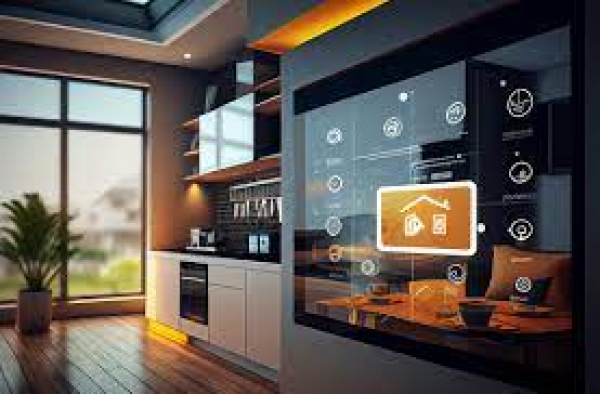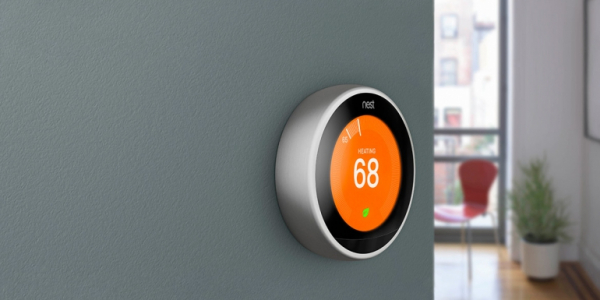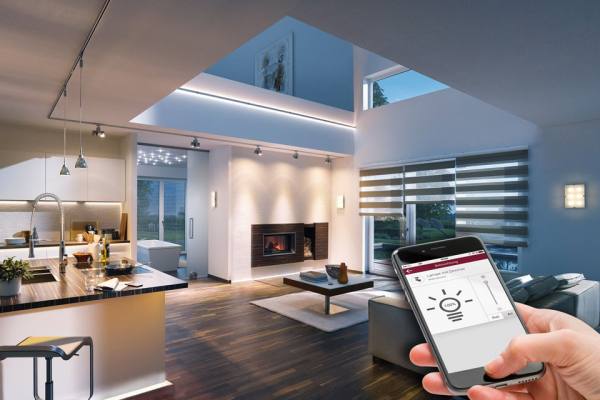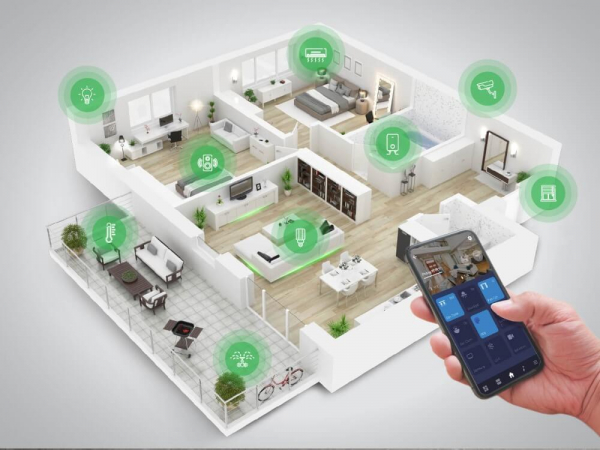What is a Smart Home?
A Smart Home is a house/apartment equipped with advanced automation systems for controlling lighting, temperature, multimedia, security, curtains, doors, and many other features to enhance comfort, safety, and efficient use of resources.
Smart homes use internet-connected devices to remotely manage and monitor systems and appliances like lighting and temperature. The Smart Home technology, also known as Home Automation, provides homeowners with safety, comfort, convenience, and energy efficiency by allowing them to control smart devices via a smart home app on their smartphone or other networked devices. As part of the Internet of Things (IoT) network, smart home systems and devices often work together, sharing user data and automating actions based on the homeowner's preferences.
Origin of Smart Homes
The release of X10 in 1975, a communication protocol for Home Automation, brought the concept of smart homes, previously a fantasy depicted in the animated series "The Jetsons," into real life. X10 sent 120 kHz radio frequency (RF) signals of digital information onto a home's existing electrical wiring to programmable outlets or switches. These signals carried commands to corresponding devices, controlling how and when the devices operated. For example, a transmitter could send a signal along the house's electrical wiring, instructing a device to turn on at a specific time.

However, as the electrical wiring was not specifically designed to filter radio waves, X10 was not always reliable. Signals could be lost, and in some cases, they wouldn't cross circuits connected to different polarities created when 220-volt service split into a pair of 100-volt feeds, common in the United States. Initially, X10 was a one-way technology, so smart devices could receive commands but could not send data back to the central network. Later, two-way X10 devices were developed at a higher cost.
When Insteon, a home automation company, emerged in 2005, it introduced technology that combined electrical wiring with wireless signals. Other protocols, including Zigbee and Z-Wave, were introduced to address issues that could arise with X10, though X10 remains a widely installed communication protocol to this day.
Nest Labs was founded in 2010 and released its first smart product, the Nest Learning Thermostat, in 2011. The company also developed smart smoke/carbon monoxide detectors and security cameras. After being acquired by Google in 2015, Nest Labs became a subsidiary of Alphabet Inc. in the same year.

In 2012, SmartThings Inc. launched a Kickstarter campaign, raising $1.2 million to support its smart home system. After securing additional funding, the company debuted in the market in August 2013 and was acquired by Samsung in 2014.
Recently, companies including Amazon, Apple, and Google have introduced their smart home products and platforms, such as Amazon Echo, Apple HomeKit, and Google Home.
Examples of Smart Home Technology
Technology has permeated every aspect of life, including the home (light bulbs, dishwashers, etc.), making smart homes a modern solution:
- Smart TVs connect to the internet and access content via apps, such as on-demand video and music. Some smart TVs include voice or gesture recognition.
- Smart lighting systems, like Philips Lighting Holding B.V.'s Hue, can detect when someone is in the room and adjust lighting accordingly. Smart bulbs can also adjust based on daylight.
- Smart thermostats, such as Nest from Nest Labs Inc., are equipped with Wi-Fi, allowing users to schedule, monitor, and remotely control home temperatures. These devices learn homeowners' behaviors and automatically adjust settings to provide maximum comfort and efficiency. Smart thermostats can also report energy use and remind users to change filters.
- Smart locks and garage door openers allow users to grant or deny access to visitors. Moreover, smart locks can detect when the homeowner is near and unlock the door.
- Smart security cameras let users monitor their homes while away. Smart motion sensors can differentiate between residents, guests, pets, and intruders, notifying authorities if suspicious behavior is detected.
- Pet care systems can automatically feed pets, while indoor plants and lawns can be watered using connected timers.
- Smart kitchen appliances include coffee makers that brew a fresh cup as soon as your alarm goes off; smart refrigerators that track expiration dates, create shopping lists, or even suggest recipes based on available ingredients; and smart ovens and toasters. The laundry room features smart washers and dryers.
- Household monitoring systems can detect electrical surges and turn off appliances; sense water failures or turn off water pipes to prevent flooding.
Advantages and Disadvantages of Smart Homes
One of the most notable benefits of home automation is peace of mind, allowing homeowners to monitor their homes remotely, combating hazards such as forgotten coffee makers or unlocked front doors.
Smart homes are also beneficial for elderly individuals, providing monitoring that allows them to stay comfortably and safely at home rather than moving to a nursing home or requiring 24/7 home care.

It is no surprise that smart homes can adapt to user preferences. For example, as soon as you arrive home, the garage door will open, lights will turn on, the heater will activate, and your favorite tunes will start playing through the speakers.
Home automation enhances efficiency. Instead of running the air conditioner all day, a smart home system can learn your behaviors and ensure the house is cooled when you return. Similarly, smart irrigation systems can water your lawn as needed with the right amount of water. With home automation, energy, water, and other resources are used more efficiently, saving natural resources and money for users.
The challenge for home automation systems to become mainstream is partly due to their perceived complexity. One downside of smart homes is the perception of complexity; some people find it difficult to use technology or may reject it if they feel frustrated initially. Smart home manufacturers and their partners are striving to reduce complexity and improve user experience, making it enjoyable and beneficial for users of all ages and skill levels.

For home automation systems to be truly effective, devices must interact with each other regardless of the manufacturer, using the same protocol or at least complementing each other. As it is a nascent market, there is no gold standard for home automation. However, standards alliances are working with manufacturers and protocols to ensure interoperability and a seamless user experience.
Another significant issue is smart home security. A 2016 NTT Data Corp. report revealed that 80% of U.S. consumers were concerned about the security of their smart home data. If hackers can breach a smart device, they can turn off lights, disable alarms, and unlock doors to gain entry. Moreover, hackers could access the homeowner's network, leading to more severe attacks or data exfiltration.
In October 2016, the Mirai IoT botnet brought down part of the internet with a series of distributed denial-of-service (DDoS) attacks using security cameras, DVRs, and routers.
Besides security, many people dislike smart homes due to privacy concerns. The NTT Data report showed that 73% of consumers were concerned about their privacy data being shared by smart home devices. Although smart home device and platform manufacturers may collect user data to better tailor their products or offer new improved services, trust and transparency are essential for manufacturers to build trust with users of their smart products.
How Do Smart Homes Work?
New homes are often built with smart infrastructure in place. On the other hand, older homes can be retrofitted with smart technology. While many smart home systems still run on X10 or Insteon, Bluetooth and Wi-Fi have become more prevalent.
Zigbee and Z-Wave are two of the most commonly used home automation communication protocols today. Both mesh network technologies use short-range, low-power radio signals to connect smart home systems. While both target smart home applications, Z-Wave has a range of over 30 meters compared to Zigbee's 10 meters, and Zigbee is often considered more complex. Zigbee chips are available from multiple companies, while Z-Wave chips are only available from Sigma Designs.

Smart homes are not just separate devices and applications; they work together to create a network that can be remotely controlled. Homeowners manage all devices through a central hub, called a smart home hub. A smart home hub is a hardware device that acts as the central point of the smart home system, capable of sensing, processing data, and wireless communication. It integrates all individual apps into a single smart home app that the homeowner can remotely control. Examples of smart home hubs include Amazon Echo, Google Home, Insteon Hub Pro, Samsung SmartThings, and Wink Hub.
Some smart home systems are built from scratch, for example, using a Raspberry Pi or a prototyping board. Other products can be purchased as a smart home kit—also known as a smart home platform—containing the necessary parts to start a home automation project.
In simple smart home models, events can be timed or triggered. Timed events follow a clock, such as lowering shades at 6 p.m., while triggered events are based on actions within the automated system; for example, when the homeowner's smartphone approaches the door, the smart lock opens, and the smart lights turn on.
Machine learning and artificial intelligence (AI) are becoming increasingly popular in smart home systems, enabling home automation applications to adapt to their environment. Voice-activated systems, such as Amazon Echo or Google Home, have virtual assistants that help learn and personalize the smart home according to user preferences and behaviors.
